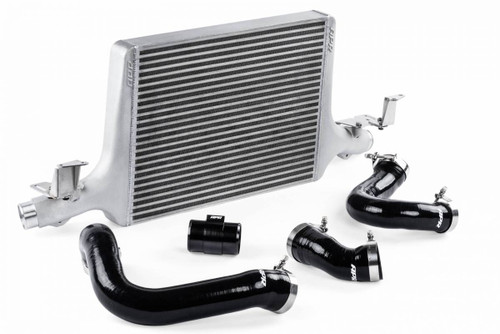 WARNING: This product can expose you to chemicals that are known to the State of California to cause cancer, birth defects or other reproductive harm. For more information, visit www.P65warnings.ca.gov.
WARNING: This product can expose you to chemicals that are known to the State of California to cause cancer, birth defects or other reproductive harm. For more information, visit www.P65warnings.ca.gov.
Intercooler Core Design
The APR Intercooler core is a large bar-and-plate design featuring densely packed staggered and louvered fins. This design offers exceptional cooling while balancing pressure loss across the core, and maintaining critical airflow to the components behind the intercooler system. The core size was appropriately matched to the platform, minimizing pressure drop while leaving adequate space for appropriately designed end tanks. To APR’s mechanical engineering experts, the design represented the ultimate in performance, far exceeding the capabilities of the factory intercooler. To the driver, the result is simple: Repeatable performance, even in the most demanding of situations!
Only use fuel equal to or higher than specified. Never use a lower octane fuel. Always follow our fuel guide, especially with race fuel and Ethanol, where available. Dynos are for reference only. Results will vary. Contributing factors include the vehicle condition, vehicle setup, dyno type, dyno setup, environmental factors, fuel quality, and more. When describing fuels, the North American Region (NAR) uses the Anti-Knock Index (AKI), (RON+MON)/2, or (R+M)/2. The Rest of the World (ROW) uses RON. RON is Research Octane Number and MON is Motor Octane Number.
This part is legal for sale or use on Racing Use Only Vehicles
The following vehicles are considered Racing Use Only Vehicles:
- Racing Use Only Vehicles are vehicles that are used exclusively for competition that are not registered and that may never be used on the street.
- PDP tag:
- Free Shipping*
- Sale:
- On Sale
- pdp tag:
- On Sale



























